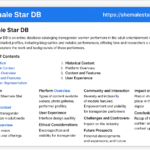Particularly for small landlords who often balance several tasks without the backing of a complete workforce, running rental properties can be both fulfilling and taxing. From tenant screening to rent collecting and spending tracking, the weight might soon be too much. Thankfully, today’s digital technologies provide workable answers. Choosing the correct property management software for small landlords will help to greatly simplify processes, lower mistakes, and free up important time.
Not all software systems, meanwhile, are built equal. Particularly, small landlords should have easy-to-use, reasonably priced, customized to their size of business software. Let’s investigate what to search for in a workable solution, how it may help small-scale landlords and a deeper look at one platform quietly acquiring popularity for the appropriate reasons.
The Reasons Small Landlords Should Use Property Management Software
Small landlords frequently oversee just a few properties personally, unlike big real estate companies with back-office workers and property managers. Directly handling tenant communication, maintenance, finances, lease documentation, and property, they are hands-on. Though fairly time-consuming, this can be gratifying.
This article shows how correct property management software for small landlords could change things:
Streamlined Rent Collection: Automated rent collecting guarantees prompt payments free from embarrassing reminders. Tenants pay by card or bank transfer; landlords are notified right away.
Expense Tracking & Accounting: Many systems today provide built-in spending classification and financial reporting, which is essential come tax season.
Document Management: Digitally archiving lease agreements, move-in guidelines, and tenant communication records helps to maintain things orderly and quickly available.
Maintenance Requests: Tenants can create online maintenance requests; landlords can assign chores, schedule repairs, and record resolution progress.
Tenant screening: Modern systems generally incorporate credit checks and background checks, therefore lowering the chance of troublesome renters.
Mobile Access: Managing properties from a phone or tablet is becoming more and more crucial for landlords who travel.
Key Features to Look For
When evaluating options, small landlords should focus on usability and functionality over feature bloat. Here are essential features that make software suitable:
User-Friendly Dashboard: An intuitive interface that doesn’t require a steep learning curve.
Automated Rent Payments: Both for one-time and recurring payments.
Income and Expense Reporting: Built-in accounting tools that track profitability and prepare for tax return.
Online Lease Signing: Enables quick, legally compliant electronic signatures.
Maintenance Coordination: A system to manage and track repair requests.
Security and Compliance: Data encryption and legal compliance, especially regarding tenant information and payment processing.
Price also plays a significant role. Many small landlords operate on tight margins, so they need solutions that provide great value without high monthly fees.
How Software Simplifies Property Management
Small landlords often find themselves dealing with minor—but time-consuming—tasks that pile up. Consider the following typical scenarios:
A tenant texts to report a leaking sink. You forget to follow up because you’re in the middle of your 9-to-5 job.
You’re trying to remember whether a tenant paid their rent, and now you’re scrolling through bank statements.
Tax season arrives, and you spend days tracking down receipts and calculating income manually.
All of these headaches can be significantly reduced—or eliminated—with the right software.
For example, with maintenance tracking, tenants submit a request through a portal. You get notified, assign it to a contractor, and the progress is tracked. For rent, the system automatically reminds tenants before the due date and alerts you if a payment is missed. When tax time comes, you export a detailed profit and loss report within minutes.
A Closer Look at Baselane
One property management solution that’s been drawing attention, especially among small landlords, is Baselane. Unlike many tools that seem geared toward larger-scale operations, Baselane seems to understand the practical needs of the solo landlord or small property owner.
Baselane combines banking, rent collection, accounting, and analytics all in one platform. What sets it apart is how it bridges the gap between financial management and property oversight. The platform offers FDIC-insured banking features tailored to landlords, including the ability to create virtual accounts for each property. This makes it easier to separate funds and track income and expenses on a property-by-property basis—an underrated but powerful feature for clarity and financial planning.
Another strength lies in its user interface. It’s neat and simple to use, and it doesn’t bombard consumers with pointless choices. This makes it especially appropriate for landlords who might not be tech-savvy or like a less cluttered experience. Simple and quick chores like posting lease documentation, encouraging renters to pay rent, or establishing bank accounts call for.
Baselane also enables automatic rent collection with customizable due dates, late fee settings, and real-time transaction tracking. Plus, tenants can pay directly from their bank accounts or with a debit/credit card, while landlords receive funds quickly with minimal delays.
What’s perhaps most valuable is its built-in financial dashboard. Baselane helps landlords see their property performance at a glance—net operating income, cash flow, and expense breakdowns. Instead of juggling spreadsheets and accounting software, everything is integrated.
That said, the platform doesn’t try to do everything. You won’t find overly complex CRM systems or multi-level permission settings designed for large teams. And that’s precisely the point. It stays focused on what small landlords need most: simplicity, control, and efficiency.
Choosing the Right Fit
With so many options on the market, small landlords should take the time to try a few platforms. Many offer free trials or freemium versions, so you can get a feel for the interface and features before committing.
Ask yourself:
- Is it easy to set up and start using right away?
- Does it support the number of units I manage?
- Can I easily generate financial reports or taxes for my accountant?
- Is customer support responsive if I run into issues?
- Is the pricing fair for the features offered?
Also, consider scalability. While you may only own two units now, what happens when you buy a third or fourth property? A good platform should grow with you.
Conclusion
To handle their rentals, small landlords have usually depended on spreadsheets, paper leases, and bank transfers. But it doesn’t have to be that way using the tools available today. Small landlords should choose the appropriate property management system to streamline daily responsibilities, lower stress, and enable professional rental company management.
Baselane and other solutions demonstrate how easily one can incorporate reporting, rent collecting, and banking into one user-friendly platform without overloading the system. Investing in good software is one of the best things you can do for long-term success, whether you run a single rental or a modest portfolio.
Remember, your time is valuable. Let technology manage your paperwork so you may concentrate on increasing your investment and reaping benefits.













